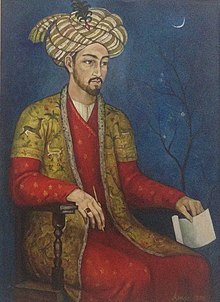Babur
This article has many issues. Please help fix them or discuss these issues on the article's talk page.
|
Babur , full name Zahiruddin Muhammad Babur (14 February 1483 – 26 December 1530) was the founder of the Mughal Empire in South Asia. He was the eldest son of Umar Sheikh Mirza, governor of Farghana.He fought and won in the first battle of Panipat.
| Zahiruddin Muhammad Babur ظهیرالدین محمد بابر | |||||
|---|---|---|---|---|---|
| Mirza | |||||
 | |||||
| 1st Mughal emperor | |||||
| Reign | 1494 - 1497, 1498 - 1500 (Ferghana) 1504 - 1526 (Kabul) 1497-1498, 1500 - 1501, 1511 - 1512 (Samarkand) 1526 - 1530 (Delhi) 20 April 1526 – 26 December 1530 | ||||
| Predecessor | Ibrahim Lodi (as Sultan of Delhi) | ||||
| Successor | Humayun | ||||
| Born | 14 February 1483 Timurid Empire (present-day Uzbekistan) | ||||
| Died | {{Death date and age|df=yes|1530|12|26|age-53years Agra, Mughal Empire (present-day India) | ||||
| Burial | |||||
| Spouse | Aisha Sultan Begum Zainab Sultan Begum Maham Begum Masuma Sultan Begum Bibi Mubarika Gulrukh Begum Dildar Begum Gulnar Aghacha Nazgul Aghacha | ||||
| Issue | Humayun Kamran Mirza Askari Mirza Hindal Mirza Ahmad Mirza Shahrukh Mirza Barbul Mirza Alwar Mirza Faruq Mirza Fakhr-un-Nissa Begum Ishan Daulat Begum Meher Jahan Begum Masuma Sultan Begum Gulzar Begum Gulrukh Begum Gulbadan Begum Gulchehra Begum Altun Bishik (alleged) | ||||
| |||||
| House | Timurid dynasty | ||||
| Father | Umar Sheikh Mirza, ʿAmīr of Fergana | ||||
| Mother | Qutlugh Nigar Khanum | ||||
| Religion | Islam | ||||
Plans of the establishment of Mughal empire
changeIn 1525 Babur set out to attack India. He had only about twelve thousand men with him but he had been promised help by Daulat Khan Lodi, the governor of Punjab. They planned to march together against the ruling Sultan Ibrahim Lodi, who was the King of Delhi at that time. When Babur reached India, the government was afraid to help him, and eventually backed out, and so Babur started off to Delhi by himself with his small army of men.
Ibrahim Lodi was reported to have one hundred thousand men and one hundred elephants. But Babur had something which Ibrahim did not have – heavy guns and cannons, the first proper Turkic style artillery seen in medieval India. There were hardly any guns at that time in India and Babur had managed to get hold of some in Kabul. He had cannons and some firearms as well. He met Ibrahim Lodi and his army at Panipat in modern Haryana.
The two armies met at the famous First battle of Panipat, at a small village near Delhi. Both armies remained in position opposite each other for a week before the battle began. Babur was an excellent general and he planned the battle very carefully as conquering Delhi was indeed very important to him. After the battle about fifteen thousand men of the enemy were killed including their commander Ibrahim Lodi.
Before the enemy could recover from their defeat, Delhi was captured.
Consolidating victory
changeBabur had to fight more major battles, the battles of Khanua and Gogra. In 1527 A.D. he had to face a fierce enemy of his at Khanua, the Rajput hero, Rana Sangram (or Sanga)of Mewar. A ferocious battle was fought between the two in the field of Khanua and Babur won the battle.
In 1529 A.D., Babur got into a battle with the Afghans. Babur won, but the Afghans were not totally weakened. They joined hands with Mahmud Lodi, the brother of Ibrahim Lodi, to fight Babur again. But Babur approached forward and was a successful winner of this Battle in Gogra.
Related pages
changeReferences
changeMedia related to Babur at Wikimedia Commons